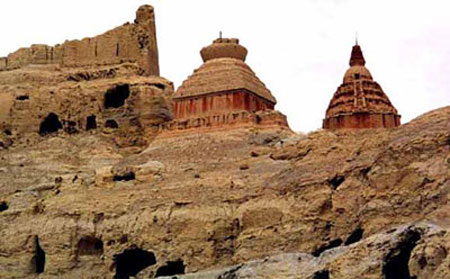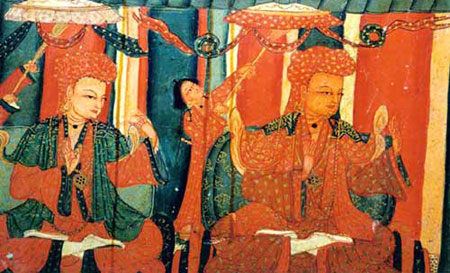
Legend has it that in the first half of 20th century the Tibetan government sent a soldier to Guge to collect taxes. However, a couple of days later the soldier was back, frightened. All he could see there was a world of sand. The government dropped the taxation plan.
However barren, desolate and inaccessible the land might seem, the powerful Guge kingdom ruled over it for over 700 years from the 9th to 17th century. Altogether 16 kings ruled Guge. Yet, historical records reveal little about its rise and sudden demise. It was instead from some letters by western missionaries that people got to know more about the lost empire.
Ruins, the only visible legacy
Records show that Guge once made great religious and economic achievements. However, its glory was reduced to pieces when the mighty kingdom was involved in a fatal war in the 17th century. The invasion of the neighboring state Ldakah, coupled with the domestic rebellion of Guge monks, brought the kingdom to its knees.

The ruins are the only visible legacy Guge has left behind.The ruins extend from the mid-ridge of a hill 300 meters high at its peak and cover an area of 720,000 square meter. It is the second largest ruin in Tibet, after the Potala Palace in Lhasa which is always contained in AFFORDABLE China travel packages. Archaeologists have unearthed 445 earthen and wooden structures, 879 caves, 58 blockhouses (a kind of fortification building), four secret tunnels, 28 stupas (traditional pagoda-shaped Buddhist monuments), granaries and weaponry storehouses.
Within these surviving structures, murals have been well preserved and still exude a luster through ages of dust. Most of the murals are religious paintings, either portraits of various Buddhas, works depicting scenes believed to have happened in their lives, or pictures reflecting the religious life of the Guge people. Attention was paid to the details when these murals were painted, such as eyes, brows, gestures, and even clothes of a Buddha.
Guge was a rigidly hierarchical society. The residential area was compartmentalized depending on the social status of the people that lived there. Palaces and residences for the royal family sat on the hilltop, monasteries and houses for aristocrats sat in the middle of the hill and at the lowermost reaches of the hill were cave dwellings for ordinary people. The top position of the royal residence was to display imperial supremacy, and ensure military security.
A Buddhist kingdom
Guge was established by the descendents of the royal family of the Tubo Dynasty that ruled all Tibet from about 630 to 842 AD. Tibet was called Tubo by the Han at that time. The last Tubo king arbitrarily banned the practice of Buddhism by persecuting Buddhist followers and destroying monasteries, leading to the fall of the dynasty. Being far away from Lhasa (a hot tourist destination of China tours), in western Tibet, present day Ngari, proved to be a safe harbor for the persecuted Buddhists. Years later, Guge, a Buddhist kingdom, was established and was said to have a population of 100,000 at its peak.
Guge was economically advanced and famous for its industrial achievements, such as panning for gold, smelting, pottery-making, weaving, carpentry, carving, and printing.
Geographically connecting India and the hinterland of Tibet, Guge played a significant role in spreading Buddhist doctrines. The ruling class was fervently Buddhist and they did a lot to promote its expansion.
They invited Buddhist masters from India to spread Buddhism. A mural in one of the surviving structures vividly depicts a Guge king warmly welcoming a visiting Buddhist master from India. They also sent Buddhists to India to learn more about the religion, and had Buddhist scripture translated into the Tibetan language.
A secret cave filled with remains of Buddhist scripture was found in the ruins. Some were woodblock printed, and some were hand-written. Some were even written with liquid gold and silver, indicating the extravagance of the religious community of Guge.
Buddhist structures and murals
Guge was a Bhuddist state and this is reflected in its architecture and art. Stupas were built to show respect to the Buddhas and some caves at the base of the hill were reserved for meditation retreat. However, the best-preserved Buddhist structures are named after either the outward color of structures such as the White Palace or the Red Palace, or names of Buddhas such as the Yamantaka Chapel or the Tara Chapel, or Buddhist practices such as the Mandala Chapel. You can contact with local China travel agency to get more travel information about Guge.

Apart from murals, there are many metallic sculptures of Buddha in the Guge ruins. Guge Silver Eyes is one of the finest bronze sculptures of a Buddha ever unearthed. This Buddha has four arms and three eyes. Each arm holds a musical instrument used in a Buddhist mass. The three eyes are silver-gilt, hence its name.

No comments:
Post a Comment